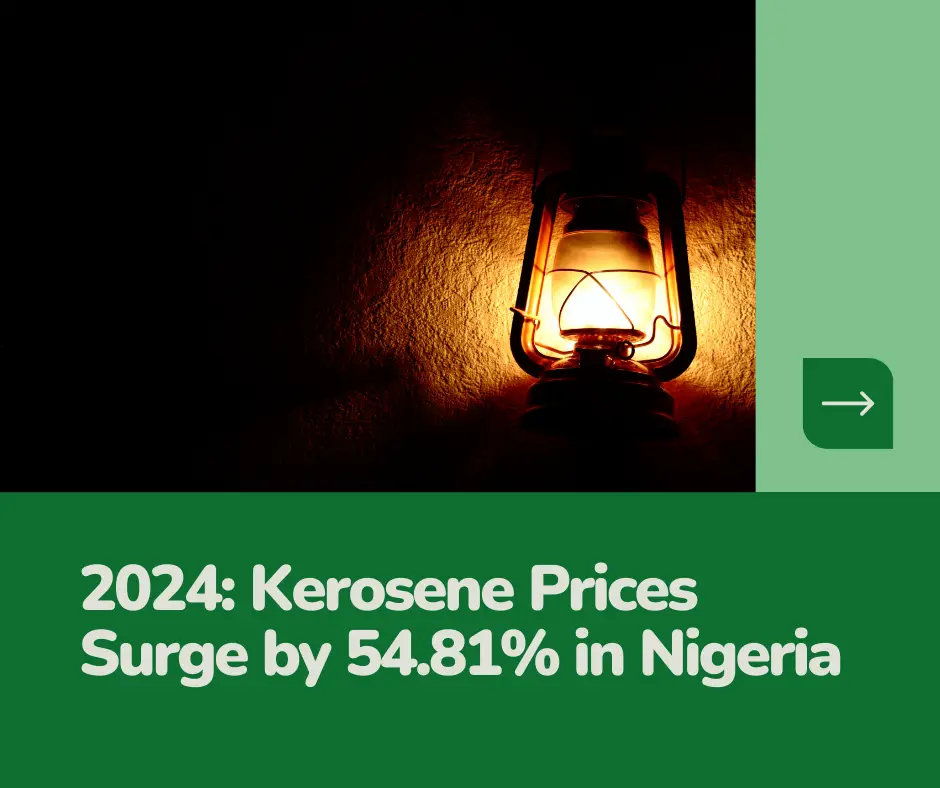
Kerosene Prices Surge by 54.81% in Nigeria: The 2024 Spike You Need to Understand
The price of household kerosene, an essential fuel for many Nigerian households, has witnessed a staggering increase. As revealed by the National Household Kerosene (HHK) Price Watch Report for October 2024, the cost per litre of kerosene rose by 54.81% compared to the same period in 2023. Let’s unpack what these figures mean for Nigerians and explore the reasons behind the surge.
The Recent Hike in Kerosene Prices
The October 2024 report from the National Bureau of Statistics (NBS) paints a vivid picture of the rising costs of kerosene across Nigeria. The average retail price per litre of household kerosene jumped to N2,017.46, compared to N1,303.16 recorded in October 2023. Month-on-month, the price also increased by 3.07% from N1,957.44 in September 2024.
In terms of geographic differences, some states experienced significantly higher prices than others:
- Abuja reported the highest average price at N2,875.00 per litre.
- Akwa Ibom and Kaduna followed closely, with prices of N2,518.89 and N2,500.79 respectively.
- On the other end, Borno reported the lowest average price of N1,500.30 per litre, closely followed by Bayelsa at N1,500.67.
These disparities reflect regional supply differences, transport costs, and access to kerosene suppliers.
Kerosene Price Variations Across Zones
Breaking down the data by zones, the North Central region recorded the highest average retail price per litre at N2,242.67, followed by the North-West at N2,168.28. The South-East had the lowest average at N1,772.94 per litre.
The regional differences can be attributed to various factors such as logistics, proximity to petroleum depots, and market demand. These differences are particularly relevant in understanding the economic burden on households in different parts of the country.
Price Per Gallon: What Has Changed?
Not only have kerosene prices per litre increased, but the price per gallon has also seen a substantial rise. In October 2024, the average retail price per gallon of kerosene was N6,949.75, indicating an increase of 1.93% from N6,818.11 in September 2024. Compared to October 2023, this represents an annual rise of 51.68% from N4,581.89.
The highest average price per gallon was recorded in Katsina at N8,900.50, followed by Jigawa and Kebbi with prices of N8,500.00 and N8,300.00 respectively. Meanwhile, Adamawa had the lowest average price per gallon at N5,300.44, followed by Nasarawa and Niger at N5,325.41 and N5,381.88 respectively.
The North-West region saw the highest average retail price per gallon at N8,070.54, while the North Central recorded the lowest at N6,176.20. The price per gallon provides insights into the buying preferences of households, many of whom buy in larger quantities to benefit from bulk pricing.
The Impact of Rising Kerosene Prices
The significant increase in kerosene prices places a heavy burden on households, especially those that rely on kerosene as their primary source of fuel for cooking and heating. Many Nigerian households depend on kerosene due to limited access to alternatives like natural gas or electricity, making this price hike a direct hit to their cost of living.
Reasons Behind the Surge
Several factors contribute to the rising prices of kerosene in Nigeria:
- Global Crude Oil Prices: The price of kerosene is directly linked to the international crude oil market. Fluctuations in crude oil prices have a direct impact on the cost of refined petroleum products like kerosene.
- Supply Chain Issues: Disruptions in the supply chain, including transportation challenges and inefficiencies in the distribution network, can lead to increased costs, which are eventually passed on to consumers.
- Inflation and Currency Devaluation: Nigeria’s inflation rate and the devaluation of the Naira also contribute to the rising cost of imported petroleum products. As the currency weakens, the cost of importing refined products increases, affecting retail prices.
- Government Policies: Any changes in government subsidies or import regulations also have an impact on kerosene pricing. Reduced subsidies can lead to a direct increase in consumer prices.
How Are Consumers Coping?
The rising cost of kerosene has forced many Nigerians to seek alternative energy sources, with some turning to firewood or charcoal, which pose environmental and health risks. Others are reducing their consumption, thereby affecting their quality of life. The situation underscores the need for affordable and accessible energy solutions for all Nigerians.
Looking Ahead: What Can Be Done?
To mitigate the impact of rising kerosene prices on households, the following measures could be considered:
- Subsidies and Price Controls: The government could consider reintroducing subsidies or implementing price controls to make kerosene more affordable for vulnerable populations.
- Promotion of Alternative Energy Sources: Encouraging the use of alternative energy sources such as liquefied petroleum gas (LPG) could help reduce dependency on kerosene. This would require significant investment in infrastructure and awareness campaigns.
- Improvement in Supply Chain Efficiency: Addressing inefficiencies in the supply and distribution chain could help reduce costs and stabilize prices. This could include better transportation infrastructure and streamlined distribution networks.
- Economic Policies to Stabilize the Naira: Ensuring a stable exchange rate would help mitigate the effects of currency devaluation on imported petroleum products. Policies that curb inflation would also help control the rising costs of essential goods like kerosene.
Conclusion
The 54.81% increase in the average price of household kerosene over the past year is a stark reminder of the challenges facing many Nigerian households. As the cost of living continues to rise, the need for affordable energy solutions becomes increasingly urgent. Addressing these challenges will require coordinated efforts from the government, private sector, and the community to ensure that all Nigerians have access to affordable and sustainable energy.
The path forward must prioritize the welfare of citizens, ensuring that energy is not just available, but accessible and affordable to all. Until then, the rising kerosene prices will continue to affect the most vulnerable, emphasizing the need for immediate and effective solutions.




